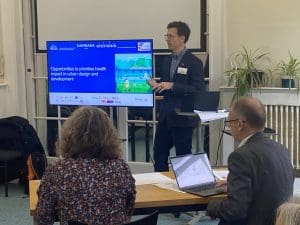Is now a good time for messaging and tools to embed health in planning to resonate?
Harry Knibb, Director with Oxford Properties has been working with TRUUD’s Changing Mindsets team during the last year to test how evidence influences pro-health thinking among urban development professionals. Here he reflects on what is needed to bring health and place closer together.
Answering a question such as this is like answering a question on when is the best time to stop smoking, or when is the best time to start being more active. The answer to all three questions is obviously now. To be clear, previously would be better, but as it’s not possible to start previously, now will have to do. This is especially true when we consider (1) the number of houses built over this parliament is front and centre of the political agenda, (2) planning regulations are being, and will be, altered to achieve the targets and (3) thanks to TRUUD and other programmes, we understand more fully both the direct and indirect links between place and health.
However, as I’ve seen over the past year of my involvement with TRUUD, knowing what to do is very different from feeling sufficiently empowered and informed to make a tangible difference. Whether that is through the projects, programmes, or schemes you may work on, or through interactions you have more broadly within the real estate sector.
 Planning is a gateway all new development must navigate – new build or retrofit, office or home – as a result, adjusting the rules, even in the slightest sense, to focus more fully on health can only be a positive ambition. Naturally, readers would expect more health equals more cost, however, this is not necessarily the case. There are many practical ways health can be integrated into real estate with no or minimal additional cost – for example, ensuring condensation is well managed in refurbishment projects or providing support to the transition to electric buildings and vehicles for better air quality and acoustic considerations.
Planning is a gateway all new development must navigate – new build or retrofit, office or home – as a result, adjusting the rules, even in the slightest sense, to focus more fully on health can only be a positive ambition. Naturally, readers would expect more health equals more cost, however, this is not necessarily the case. There are many practical ways health can be integrated into real estate with no or minimal additional cost – for example, ensuring condensation is well managed in refurbishment projects or providing support to the transition to electric buildings and vehicles for better air quality and acoustic considerations.
The challenge of course is timing – healthy benefits (or costs) take time to materialise and as Mark Carney coined in his landmark speech in 2015 for sustainable development, healthy development too suffers from the ‘tragedy of the horizon’. Because of this, policy must play a role. I’m hopeful we will build more over the coming years, delivering the homes, offices, laboratories, warehouses, and infrastructure which is all critically needed, in a way that supports healthy and fulfilling lives, and as a result, endures the test of time.



